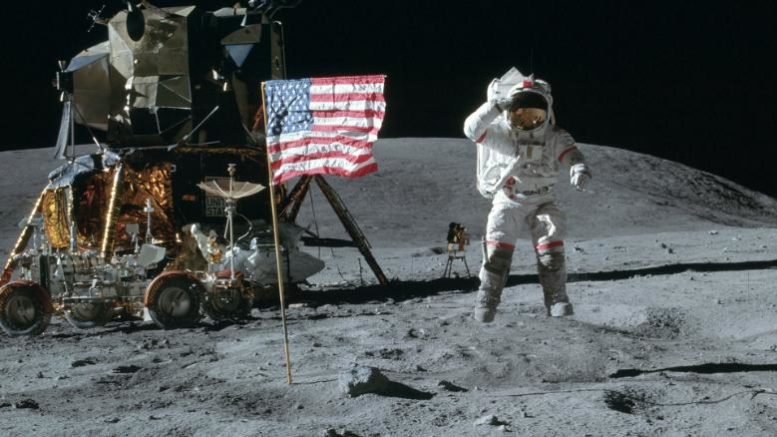Fifty years ago today, the first human — and one of the only humans — took steps on the moon. This was humanity’s first landing on another heavenly body and at the time, it was astounding. It was also controversial, a fact which is mostly forgotten today. Most people alive in 2019 weren’t even born, and yet in many ways the sheer audacity of this event still hasn’t been topped. Let’s take a look.
The conventional story
The commonly accepted history of the moon landings begins during the Second World War. Rockets had been used for hundreds of years for warfare, but never with such deadly accuracy as the huge and complex models created by Germany. Even though the Axis lost the war eventually, the world was convinced that rockets held the key to winning the future.
Both the United States and the Soviet Union, then ideological enemies, captured German rocket scientists and convinced them to develop rocket technology for even more long-distance use. The goal was plain: develop a missile that could deliver a nuclear bomb to the other side. Such a weapon would be so terrible, it was thought, that anyone who had it would win by default.
There was a little bit of a detour, though. Both sides also understood the power of propaganda, and the best way to show a nervous world who’s boss is to do something really public. The winner of the early PR race was the Soviet Union, who launched the world’s first artificial satellite in 1957. Even ham radio operators could detect its signal as it orbited once every 90 minutes. For Americans, that beep every hour and a half was a persistent reminder that someone else had the high ground.
Manned missions
Manned space missions in the United States were originally envisioned in the late 1950s but the idea of a moon landing was proposed by President John Kennedy. His untimely death lent an air of importance to the project. It became, for a time, a national obsession.
The first missions were not without risk. But, early astronauts were military men who knew what was expected of them. After a lot of trial and error, and a lot of calculations by brave engineers on the ground, the first manned mission to land on the moon took place in mid-1969, just 18 months before the self-imposed goal of the end of the decade.
What it was like on that moment
I’ll admit that I don’t remember it. Most people alive won’t remember it, just a swath of aging baby boomers. Fewer and fewer people living today will remember it as time goes by. I’ve read a lot about that moment. As much as we like to believe it was a time when the whole world came together to sing “kum ba ya” that really isn’t the truth. Yes, I think a lot of people stopped what they were doing and marveled.
The first manned moon landing was an incredible achievement, yes. It was done using math that had barely been invented, using computers less powerful than a student’s scientific calculator. It was done with a lot of guts and very little understanding of what would actually happen. In 1969 there was practically no data on what space travel would even do to people. It wasn’t even clear if people could even swallow without gravity. Yet, despite all the odds, we did it. We did it and the astronauts who went to the moon actually lived to tell about it. That, perhaps, was the greatest triumph. One, Dr. Edwin Aldrin, is still alive today.
But, not everyone was on board
Believe it or not it was the younger generation whose enthusiasm with space travel waned first. Space travel was seen as an expensive form of military brinksmanship. Few people saw the value of pure science. Counterculture papers of the day talked about the starving people on Earth, and how much poverty could be wiped out if the same money was spent on welfare that had been spent on space.
Space travel, though exciting to some, was often seen as an expensive folly with little practical application. Of course we know that not to be true now, as most of the advances in computer technology, higher math, biology, and telecommunications can be linked back to the US’s space program. It was the urge to go “out there” that brought a massive spurt of tech growth to practically every industry.
Eventually, NASA funding was cut so severely that the agency struggles today to stay afloat. Major programs, used for PR purposes by one administration, are cut by the next.
Will there ever be another moment like that?
I honestly don’t know. When you look at the moon landing it was an incredibly impressive, but ultimately symbolic moment. It has driven the last 50 years of tech growth, but it seems to me that we need more than that today. In the last fifty years we have become more focused on results and less focused on grand gestures.
If there is another world-stopping moment like the moon landing, I suspect it would have to be something that really did bring a direct, tangible benefit to people on Earth. I do think the world needs such a moment, and I hope we get it soon.
I know that the real story of the moon landing isn’t as clear or straightforward as most of the tales you’ll hear today. That doesn’t make it any less impressive. 50 years later, it stands as one of the defining moments in human history, and something that multiple generations can look back on with pride.

